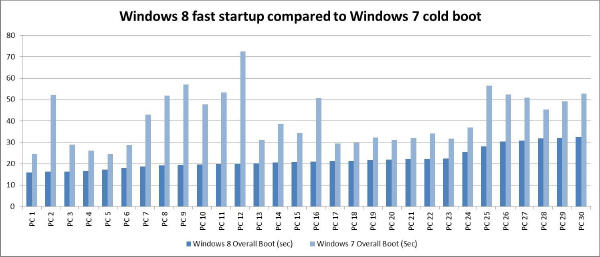Microsoft’s next-generation operating system Windows 8 promises to be capable of enabling computers to enjoy faster boot-up times. In addition, the new OS will result in a zero watt power draw when turned off.
The software giant’s head of Windows development Steve Sinofsky is continuing with his series of reveals (a countdown, perhaps?) and this time has published a remarkable insight into how the new OS will function on existing personal computers, not to mention the coming spate of ultrabooks.
According to a post in the blog authored by Gabe Aul, a director of programme management in Windows, few operations in Windows are as scrutinised, measured and picked apart as boot.
Data shows that 57pc of desktop PC users and 45pc of laptop users shut their machines down rather than putting them to sleep.
Overall, half of all users shut their machines rather than putting them to sleep. Ostensibly this is because they want to reduce energy use. As well as this, many users want a “fresh start” rather than running software from their previous session.
While sleep/resume is the best option for fast on/off, it still consumes power to preserve the contents of RAM, ultimately draining the battery.
Aul said Windows 8 has been designed in such a way to ensure zero watt power draw when off, a fresh session after boot and fast times between pressing the power button and being able to use the PC.
“In Windows 7, we made many improvements to the boot path, including parallel initialisation of device drivers, and trigger-start services, but it was clear we’d have to get even more creative (and less incremental) if we hoped to get boot performance anywhere close to fast enough to meet all of these needs.
“Our solution is a new fast start-up mode which is a hybrid of traditional cold boot and resuming from hibernate.”
Microsoft wakes hibernation from its sleep
One of the ways Microsoft has been able to achieve these goals has been to overhaul how hibernation works, in particular, hibernating the kernel session.
This takes up substantially less time to write to disk and results in boot times that can be 30pc-70pc faster.
“It’s faster because resuming the hibernated system session is comparatively less work than doing a full system initialisation, but it’s also faster because we added a new multi-phase resume capability, which is able to use all of the cores in a multi-core system in parallel, to split the work of reading from the hiberfile and decompressing the contents,” Aul said.
“For those of you who prefer hibernating, this also results in faster resumes from hibernate, as well.”
Aul said the new fast start-up mode will benefit most personal computers, whether they have a spinning hard disk drive or a solid state drive (SSD).
“But for new systems with fast SSDs, it is downright amazing.”
